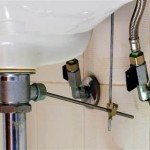Selecting the Right Bathroom Sink: A Comprehensive Guide
The bathroom sink, often referred to as the washbasin, is a fundamental fixture in any bathroom. It serves not only a functional purpose for washing hands, brushing teeth, and general hygiene, but it also contributes significantly to the overall aesthetic and design of the space. With a vast array of styles, materials, and installation options available, selecting the right bathroom sink can be a complex decision. This article will explore the various factors to consider when choosing a bathroom sink, providing information to guide informed decision-making.
The selection process requires careful consideration of several aspects. These include the available space within the bathroom, the existing plumbing configuration, the desired style and finish, and the budget allocated for the project. Compromising on any of these factors may result in dissatisfaction with the final outcome. Therefore, a thorough understanding of the different types of sinks and their respective advantages and disadvantages is crucial.
Understanding Types of Bathroom Sinks
Bathroom sinks are classified based on their installation method and design. Each type offers unique advantages and disadvantages in terms of aesthetics, functionality, and ease of installation. The most common types include:
1. Undermount Sinks: Undermount sinks are installed beneath the countertop, creating a seamless transition between the sink and the surrounding surface. This type of sink is often preferred for its clean and modern appearance. The absence of a visible rim makes it easier to wipe debris directly from the countertop into the sink. However, undermount sinks require a solid surface countertop material, such as granite, marble, or quartz, as they cannot be used with laminate countertops due to the exposed edge.
The installation of an undermount sink typically involves securing it to the underside of the countertop with clips and adhesive. This requires precise cutting and sealing to prevent water damage. While the installation can be a DIY project for experienced individuals, professional installation is often recommended to ensure a watertight seal and proper support.
2. Vessel Sinks: Vessel sinks, also known as above-counter sinks, sit on top of the countertop, resembling a bowl or basin. This style offers a dramatic and visually striking focal point for the bathroom. Vessel sinks are available in a wide range of shapes, sizes, and materials, allowing for greater design flexibility. They can be paired with a variety of countertop materials, including solid surface, wood, and glass.
The installation of a vessel sink is generally simpler than an undermount sink. It typically involves drilling a hole in the countertop for the drain and securing the sink with sealant. However, it is important to select a faucet that is tall enough to reach over the rim of the sink. Also, consider that due to the raised height of the sink, the countertop might need to be lower than standard to ensure comfortable usability.
3. Pedestal Sinks: Pedestal sinks are freestanding units that consist of a sink basin supported by a pedestal base. This type of sink is ideal for smaller bathrooms as it requires minimal floor space. Pedestal sinks offer a classic and elegant aesthetic, and they are available in a variety of styles to complement different bathroom designs. A significant limitation of pedestal sinks is that they offer little to no storage space.
The installation of a pedestal sink involves securing the pedestal base to the floor and the sink basin to the wall. Plumbing connections are typically concealed within the pedestal base. While the installation is relatively straightforward, it may require some plumbing modifications to ensure proper drainage and water supply.
4. Wall-Mounted Sinks: Wall-mounted sinks are attached directly to the wall, without the need for a countertop or pedestal. This type of sink is another excellent choice for small bathrooms as it maximizes floor space. Wall-mounted sinks offer a minimalist and modern aesthetic, and they can be installed at various heights to accommodate different users.
The installation of a wall-mounted sink requires a strong wall structure to support the weight of the sink and water. It is crucial to ensure that the wall studs are properly reinforced before installation. Plumbing connections are typically exposed beneath the sink, although they can be concealed with a decorative shroud or trap. This exposed plumbing can sometimes be considered a design feature itself depending on the overall aesthetic.
5. Console Sinks: Console sinks combine the aesthetic appeal of a pedestal sink with the added functionality of a countertop. They feature a sink basin supported by legs or brackets, with a countertop surface surrounding the sink. Console sinks offer a balance of style and practicality, providing storage space for toiletries and other bathroom essentials.
The installation of a console sink involves securing the legs or brackets to the floor and the sink basin to the wall. Plumbing connections are typically concealed beneath the countertop. Console sinks offer a more substantial look than pedestal sinks, making them a suitable choice for larger bathrooms.
6. Drop-in Sinks: Drop-in sinks, also known as self-rimming sinks, are installed into a pre-cut hole in the countertop. The rim of the sink sits on top of the countertop, creating a visible edge. Drop-in sinks are a versatile option that can be used with a variety of countertop materials. They are relatively easy to install and offer a wide range of styles and sizes. However, cleaning around the rim can sometimes be challenging.
The installation of a drop-in sink involves simply placing the sink into the pre-cut hole and securing it with clips or sealant. The weight of the sink is supported by the countertop. This type of sink is a popular choice for DIY projects due to its ease of installation.
Choosing the Right Material
The material of the bathroom sink significantly impacts its durability, aesthetics, and maintenance requirements. Common sink materials include:
1. Porcelain: Porcelain is a classic and widely used material for bathroom sinks. It is durable, non-porous, and easy to clean. Porcelain sinks are available in a variety of colors and styles, making them a versatile choice for any bathroom design. However, porcelain can be susceptible to chipping or cracking if subjected to impact.
2. Ceramic: Ceramic is similar to porcelain but is typically less expensive. It is also durable and easy to clean, but it may be more prone to staining or scratching than porcelain. Ceramic sinks are a popular choice for budget-conscious homeowners.
3. Glass: Glass sinks offer a unique and contemporary aesthetic. They are available in a variety of colors, shapes, and textures, adding a touch of elegance to any bathroom. Glass sinks are non-porous and easy to clean, but they can be more fragile than other materials and may require more careful handling. Tempered glass is generally used for sinks to improve durability.
4. Stone: Stone sinks, such as granite, marble, or travertine, offer a luxurious and natural look. They are durable and can withstand high temperatures, but they require regular sealing to prevent staining and water damage. Stone sinks are typically more expensive than other materials.
5. Stainless Steel: Stainless steel sinks are a durable and hygienic option for bathrooms. They are resistant to staining, scratching, and corrosion, making them ideal for high-traffic areas. Stainless steel sinks offer a modern and industrial aesthetic.
6. Cast Iron: Cast iron sinks are durable and long-lasting. They are typically coated with enamel to provide a smooth and non-porous surface. Cast iron sinks are heavy and may require additional support during installation.
Factors to Consider Before Purchase
Beyond the type and material, several other factors should be considered before purchasing a bathroom sink:
1. Size and Shape: The size and shape of the sink should be appropriate for the available space and the intended use. Consider the dimensions of the countertop or vanity and the amount of space needed for comfortable washing. Choose a shape that complements the overall design of the bathroom.
2. Faucet Compatibility: Ensure that the sink is compatible with the chosen faucet. Consider the number of faucet holes required and the placement of the faucet on the countertop or sink. Determine if a widespread, centerset, or single-hole faucet is desired.
3. Overflow Drain: An overflow drain prevents water from overflowing the sink in case the drain is blocked. Consider whether an overflow drain is necessary based on usage habits and potential risks of overflow.
4. Budget: Bathroom sinks range in price from affordable to luxurious. Establish a budget before beginning the selection process to narrow down the options and avoid overspending. Consider the cost of installation and any necessary plumbing modifications.
5. Maintenance Requirements: Consider the maintenance requirements of the chosen sink material. Some materials, such as stone, require regular sealing, while others, such as stainless steel, are relatively low-maintenance.
6. Code Compliance: Ensure that the chosen sink meets local building codes and regulations. This may include requirements for drainpipe size, water supply connections, and accessibility standards. Consultation with a licensed plumber can help ensure compliance.
Careful consideration of these factors will lead to a bathroom sink selection that is both aesthetically pleasing and functionally sound. The proper sink will enhance the overall bathroom experience for years to come.

Home Decorators Collection Aiken 42 In W X 22 D 34 H Single Sink Bath Vanity Almond Latte With White Engineered Marble Top 42al The Depot

Home Decorators Collection Aiken 42 In W X 22 D 34 H Single Sink Bath Vanity White With Engineered Marble Top 42w The Depot

Glacier Bay Sinita 42 In W X 19 D 34 H Single Sink Bath Vanity Natural Oak With White Engineered Stone Top 42no The Home Depot

Fairmont Designs 1711 V42 Design Studio 42 Bathroom Vanity Qualitybath Com

42 Inch Single Bathroom Vanity In Black With Backsplash Elegant Lighting Vf16442bk Bs

Marina 42 Bathroom Vanity Driftwood Finish Ari Kitchen Bath

Ove Decors Athea 42 In Pure White Undermount Single Sink Bathroom Vanity With Engineered Stone Top The Vanities Tops Department At Com

42 Italian Portoro Marble Vigo Vessel Sink Bathroom Vanity Hf1214 Bentoncollections

Ari Kitchen And Bath Annie 42 In Vanity Weathered Fir With Marble Top Carrara White Basin Akb Weathfir The Home Depot

42 Inch Walnut Vessel Sink Bathroom Vanity With Side Cabinet
Related Posts







